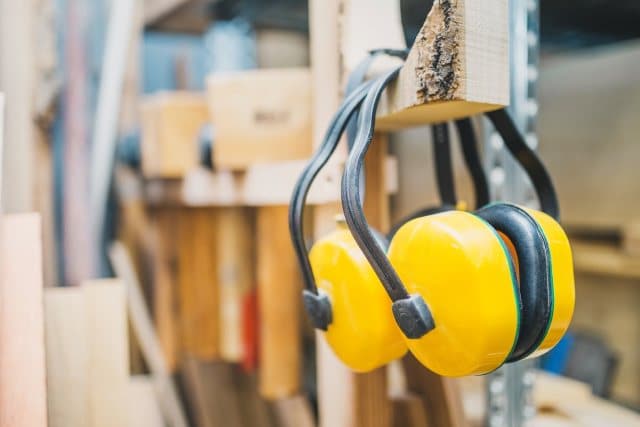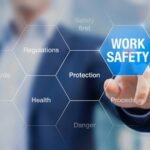Noise has been an occupational hazard for hundreds of years dating back to ancient and medieval times. In those days, city dwellers dealt with noise from carriages on cobblestone streets while craftsmen such as blacksmiths and tinsmiths were exposed to loud sounds while performing their trades.
In the early 1700s, Bernardino Ramazzini, an Italian physician considered the father of occupational medicine, noted that the deafness of coppersmiths was due to their loud work environment. In the 18th century, the Industrial Revolution brought many technological advances but also introduced new, noisy machinery which exposed more workers to noise hazards as they worked in factories. Today, the Centers for Disease Control (CDC) estimates that 22 million workers are exposed to hazardous occupational noise and if left uncontrolled, noise exposure can cause permanent noise-induced hearing loss (NIHL).
October is National Protect Your Hearing Month (#NPYHM) and a good time to be reminded of the importance of protecting ourselves from hearing loss. Hearing loss can affect communication and has been associated with cognitive decline in older adults. Additionally, hearing impairment can affect a person’s quality of life by limiting one’s ability to fully participate in conversations. The mining, construction, and manufacturing industries have a high incidence rate of noise exposure with some estimates suggesting half of all construction workers have some hearing loss. But it is not only those industries that are affected. Hearing impairment affects many other occupations and industries, such as transportation, the military, landscapers, firefighters, agricultural, maintenance, and factory workers.
Hearing loss in the workplace can happen in three ways:
- Long-term continuous exposure at or above 85 decibels can cause hearing loss. Keep in mind noise exposure is cumulative.
- Single exposure to a high-level sound, also known as acoustic trauma involves loud impact noises near the ear.
- Ototoxic chemical exposure. Solvents such as carbon disulfide, xylene, toluene, styrene, metals such as lead and mercury, asphyxiants such as carbon monoxide, and other substances can all cause hearing loss as these chemicals can affect the auditory system. Be aware that hearing loss can be greater with exposure to both ototoxic chemicals and noise combined, than noise or ototoxic chemicals alone.
OSHA requires that hearing protection be used when noise exposure is at or above 85 decibels averaged over 8 working hours, or an 8 hour time- weighted average (TWA). Regarding ototoxicants, the OSHA standards require employers to maintain exposure to the specific substance at or below the Permissible Exposure Limit (PEL). Keep in mind, ototoxic chemicals combined with noise could result in hearing loss due to the synergistic effects, even below the PEL. Hearing loss is often gradual and different from other workplace injuries in that it might not be immediately noticeable. Noise-induced hearing loss can be permanent. Exposure to ototoxic chemicals can cause hearing loss, tinnitus (ringing in the ears), and problems with balance. Hearing aids can help but do not return your hearing to normal. Another reason to protect yourself and to be proactive when exposed to loud noise.
Sound is measured in decibels (dB) with sound measuring instruments such as sound level meters, noise dosimeters, and octave band analyzers used to measure sound levels in the workplace. Also, the NIOSH Sound level meter app can be easily downloaded to check noise levels. For reference, the average decibel ratings of some everyday noises are as follows: Please note that sound levels of about 120 decibels can cause pain in the ear.
- Whisper, rustling leaves-20 decibels
- Humming of a refrigerator-40 decibels
- Normal conversation-60-80 decibels
- Movie theater-70-104 decibels
- Motorcycles-80-110 decibels
- Loud concert-95-115 decibels
- Jackhammer-115-120 decibels
- Carolina Hurricanes game at PNC Arena (loudest in NHL)100-136 decibels
- Fireworks show-140-160 decibels
- Rocket Launch-180 decibels
Hearing conservation programs should include these seven elements:
- Monitor employee noise exposures-Identify the need.
- Control the noise-Rotate employees, limit time of exposure, and use engineering controls such as the substitution of equipment, isolation, etc.
- Protect-Use hearing protection with an adequate noise reduction rating.
- Check-Baseline and annual audiometric testing.
- Train-Annual training on noise exposure, how to choose hearing protection, and educate employees on noise and ototoxic chemicals.
- Record-Keep up-to-date records.
- Evaluate-Prevent further occupational hearing loss.
Hearing Protection Devices (HPDs) include options such as:
- Ear muffs that completely cover the outer ear.
- Canal Caps which resemble ear plugs, but are on a flexible plastic or metal band making them convenient.
- Expandable foam plugs which are made of a formable material designed to expand and conform to the ear.
- Pre-molded, reusable plugs which are made from silicone, plastic, or rubber and are relatively inexpensive. These should seal the ear canal without being uncomfortable.
Occasionally, two types of hearing protection may need to be combined. Hearing protectors must adequately reduce the noise level in the work environment. Some general advice about hearing protection devices includes washing your hands beforehand and remembering the three C’s: C-Comfort, so you’ll wear it, C-Consistency, use it every time, C- Cleanliness, don’t expose your ear to harmful bacteria. Identify ototoxicants in the workplace by reviewing the Safety Data Sheets (SDS) and determine the appropriate Personal Protective Equipment (PPE) such as respiratory protection and hand protection when working around harmful chemicals and substances which can also damage your hearing. When possible, replace a hazardous chemical with one less toxic. Use engineering controls such as enclosures or isolation to reduce or eliminate the noise hazard. Ventilation is also recommended when working around ototoxic chemicals.
There are some simple ways to protect yourself from noise exposure whether at work or at home. Be alert to hazardous noises in the environment. Educate yourself about hearing loss and hearing protection. Always use hearing protection devices when around loud noise. Distance yourself from noise when possible. Take breaks from the noise. Limit the amount of time you are exposed. Make sure your hearing is protected and if you suspect a problem with your hearing, get checked by a physician.
Noise is part of our everyday life, but prolonged noise exposure can cause chronic stress, elevated blood pressure, anxiety, fatigue, communication issues, and tinnitus in addition to the risk of hearing loss. According to the World Health Organization (WHO), noise-induced hearing impairment is the most common irreversible occupational hazard. Employers must train employees exposed to TWAs of 85 dB and above at least annually about the risks of noise, the various options for hearing protection, and the purpose and procedures of audiometric testing. OSHA’s Noise Standard requires the employer to reduce noise exposure through engineering controls, administrative controls, or Hearing Protection Devices within specified limits. Workers have a right to working conditions that do not pose a risk of serious harm and to receive information and training about workplace hazards including hearing protection. Be sure to use this National Protect Your Hearing Month to get educated on noise hazards and protect your employee’s hearing with a hearing conservation program, if necessary. Call us at 919-417-2139 or send us an email at if you have questions or need more information about hearing protection, hearing conservation programs, or need further guidance. We are committed to helping you keep your employees safe and we are always available to assist.


